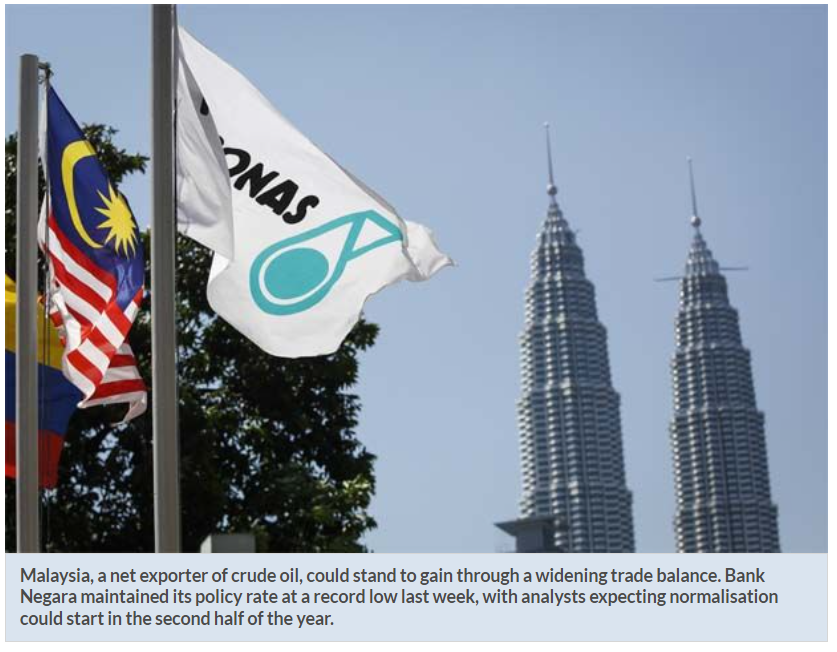Here’s how surging oil prices shift the economic outlook in Asia, Malaysia a gainer
SINGAPORE: Oil’s relentless surge above $125 (RM522.95) a barrel threatens to stoke inflation across Asia, forcing central banks to decide whether to respond to higher prices with tighter policy, or hold off amid the blow to economic growth.
As a net importer of energy, Asia is vulnerable to the oil price spike triggered by Russia’s invasion of Ukraine.
And with more than 40% of global exports stemming from the region, any sustained price increases will ripple throughout the world.
“Most are huge energy importers, so soaring crude and gas costs will weigh on economic growth,” said Frederic Neumann, co-head of Asian economic research at HSBC Holdings Plc. “But the inflation impact is also substantial, even if the precise impact on individual markets varies. A delicate balancing act for central banks.”
Here’s a guide to how the oil surge is impacting Asia’s biggest economies:
China
China, the world’s largest oil importer, faces a squeeze on companies’ profits and consumer spending power, as well as slower demand for its exports – complicating Beijing’s effort to stabilize a slowing economy.
Working in China’s favour is its large domestic energy supplies, close ties with Russia and low consumer inflation.
China experienced high producer price inflation (PPI) last year due to soaring costs for metals and coal, meaning base effects should keep a lid on PPI growth this year.
China imported more than US$257bil (RM1.08bil) worth of oil last year, according to official statistics.
“China’s core consumer price index remained subdued, so China’s full-year inflation is generally controllable from this perspective,” said Wen Bin, chief researcher at China Minsheng Bank.
Japan
The leap in oil prices increases the likelihood of inflation accelerating in Japan, but it’s unlikely to prompt the Bank of Japan (BoJ) to step back from stimulus.
That’s because economic growth continues to underwhelm.
Oil prices are well beyond levels the BoJ sees as pushing inflation past its latest forecast, according to people familiar.
Yet normalising monetary policy isn’t realistic until inflation stays above its 2% goal in a sustainable manner.
“Inflation might hit 2% briefly, and we could see it rising further toward summer, but it’s unlikely to stay at 2% stably,” said Takeshi Minami, chief economist at Norinchukin Research Institute.
“The problem is that as the energy costs for consumers rise, they’ll spend less on other things, and when that happens, it’s hard for 2% to be reached in a stable manner.”
India
The surge in edible and crude oil prices are bound to feed into headline inflation, which has already breached the upper tolerance limit of the Reserve Bank of India’s (RBI) 2%-6% target range.
While the RBI has blamed supply side shocks for the spike, higher prices will nevertheless eat into disposable incomes of consumers, the backbone of the economy that has yet to fully start spending after the pandemic.
While the central bank may have to raise its inflation forecast, there may be little scope for it to tighten monetary policy amid the deteriorating global growth outlook.
South Korea
South Korea is worried the costs of energy will rise due to the war and hurt its bottom line in exports.
The country’s manufacturing industries rely heavily on imports for energy and the nation only just returned to a surplus in trade in February after a two-month deficit caused by high oil prices.
Inflation among consumer prices is also quickening faster than expected, driven by energy. Prices last month rose 3.7% from a year earlier, well above the central bank’s target of 2%, even after three interest-rate hikes by the Bank of Korea since August.
Still, South Korea’s relatively small economic ties with Russia have helped limit direct impact from the war.
Australia
Australia’s position as a net energy exporter means it is partly buffered from the oil shock.
The nation is a major exporter of liquefied natural gas, shipments of which hit a record high in 2021 driven by a surge in energy demand and prices.
The trade surplus widened in January, the largest windfall since August. Economists expect an ongoing boost to export revenue and national income.
South-East Asia
In Indonesia, South-East Asia’s largest economy, subsidies on basic items like cooking oil, liquefied petroleum gas, fuel and electricity have softened the blow of the global commodity rally on consumers.
February inflation stood at 2.06%, at the low end of the central bank’s 2%-4% target range, giving authorities breathing room should they decide to keep interest rates at record lows next week.
However, the subsidies come at a heavy cost for the state budget and the cash flows of Indonesia’s state-owned oil firm.
The sharp increase in global crude prices is pressuring the government to consider raising the administered prices for gasoline, estimating PT Pertamina could book losses of US$500mil (RM2.09bil) monthly if it doesn’t.
The likes of Thailand and the Philippines will likely be pummelled as higher oil prices cause knock-on effects to transport and food costs, according to Nomura Holdings Inc.
Thailand inflation hit its highest since 2008 last month as the nation struggled with rising food and energy costs.
Meanwhile, Bangko Sentral ng Pilipinas governor Benjamin Diokno estimates inflation could breach its target and reach as high as 4.4%-4.7% under a “worst-case scenario”.
Malaysia, a net exporter of crude oil, could stand to gain through a widening trade balance. Bank Negara maintained its policy rate at a record low last week, with analysts expecting normalisation could start in the second half of the year. — Bloomberg


 English
English




